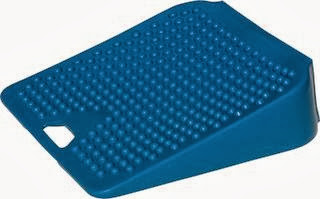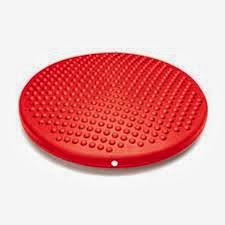1) Self-Implemented Self-Regulation Break
I have a student that has a difficult time with self-regulation skills. In addition to implementing the Zone's of Regulation for this student/class, we are giving him a self-implemented self-regulation break. He has a timer, which is set for 5 minutes, that is attached to the door. When he feels like he is sad or going to cry, he is able to take the timer and go for a walk/drink/bathroom break. He always returns on time after his 5 minutes are up and quickly returns back to work in his general education classroom.
2) Wiggle Cushions!
Wiggle cushions are a great way to get the wiggles out! Wiggle cushions are great for students who: need to move during seated instruction, or have poor writing posture.
Tuesday, September 24, 2013
Friday, September 6, 2013
Weekly Top 3
I took some Nyquil and am not in a focused state of mind. I can't believe I made it almost 3 weeks before getting sick :) Hope you all are staying healthy!
1) Thinking Notepad. Hold that Thought cards may not work for every child. For example the student that has no impulse control and has the incessant need to share every thought that comes to mind. In order to satisfy his need to be heard, I placed a small pad of paper on his desk; with this pad of paper he is encouraged to write down his comments and questions. We then read the paper throughout the day and make time to discuss the comments and questions with him.
2) Aroma Therapy. Use different aromas to help alert or calm a student. Use citrusy or minty smells to alert, and smells such as lavender to calm. Simply place a drop of essential oil or fragrance onto a cotton ball or tissue.
3) Cover the sink! We have sinks in each and every classroom in our building, while this is beneficial, especially in a preschool classroom, it does create a problem. I have students who would play in the water for hours if I would let them. So for a quick and easy fix I grabbed this file box from Walmart for super cheap...And it gets the job done! You may want to use a solid colored box if this is not enough.
And here is a bonus intervention for the teacher:
DONUTS! Let's be truthful, it is much easier to come to work on Friday's knowing that there will be donuts!
1) Thinking Notepad. Hold that Thought cards may not work for every child. For example the student that has no impulse control and has the incessant need to share every thought that comes to mind. In order to satisfy his need to be heard, I placed a small pad of paper on his desk; with this pad of paper he is encouraged to write down his comments and questions. We then read the paper throughout the day and make time to discuss the comments and questions with him.
2) Aroma Therapy. Use different aromas to help alert or calm a student. Use citrusy or minty smells to alert, and smells such as lavender to calm. Simply place a drop of essential oil or fragrance onto a cotton ball or tissue.
3) Cover the sink! We have sinks in each and every classroom in our building, while this is beneficial, especially in a preschool classroom, it does create a problem. I have students who would play in the water for hours if I would let them. So for a quick and easy fix I grabbed this file box from Walmart for super cheap...And it gets the job done! You may want to use a solid colored box if this is not enough.
And here is a bonus intervention for the teacher:
DONUTS! Let's be truthful, it is much easier to come to work on Friday's knowing that there will be donuts!
Thursday, September 5, 2013
Things I learn in second grade: Math
As I mentioned before, I am only in the second general education classroom for 1/2 of my day, and everyday I learn something new. So do not make fun that I do not have this information in my repertoire, or maybe I do and I just have different terminology for it, or maybe I have been teaching at the preschool level too long; either way, Second graders raise the bar!
This week I have learned:
1) Commutative Property
2) Landmark Numbers
3) String Addition
These things of course make sense to me, and I do use them, but let's be honest...Who actually knew that it was called something?
This week I have learned:
1) Commutative Property
2) Landmark Numbers
3) String Addition
These things of course make sense to me, and I do use them, but let's be honest...Who actually knew that it was called something?
Tuesday, September 3, 2013
Weekly Top 5
 |
| Wait/Hold that Thought Card |
1) Hold That Thought Card
We use this card when students really want to share something, but it is not the time. During the lesson the teacher/aide will hand the student the card (this can be if they begin to talk or if their hand is raised). At the end of the lesson, or a designated time, the student is able to turn in the card and share their thought. Click here to download a "hold that thought" card.
2) Flip Schedule
Use this for students who travel or are higher functioning. To make this you need two pieces of paper laminated and spiral bound together, velcro, and a dry erase marker. As a student completes the task, you or the student can flip the paper over to show that the task is finished.
3) All Done Bins
Use all done bins to put in items/tasks/activities when they are completed. It is important to know that once an item/activity has been completed and placed in the all done bin, DO NOT take it out in front of the student, it is very probable that they will have a meltdown.
4) Swing!
Swining is a quick and easy sensory/engine break, and the perfect way to wake up a students' engine.
5) Highlighted Paper
Highlight every-other line to help with spacing and letter formation, as well as allowing room to edit students' work.
Subscribe to:
Posts (Atom)





